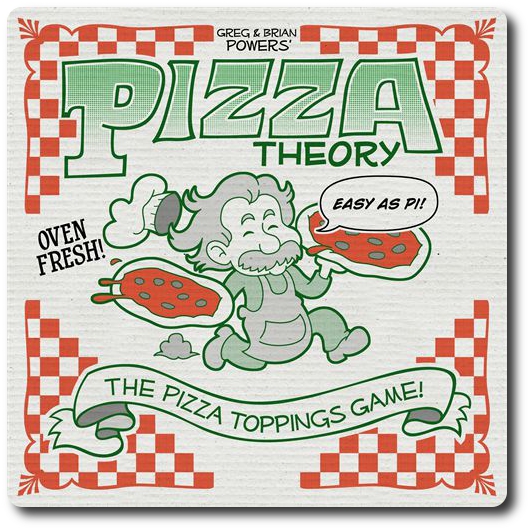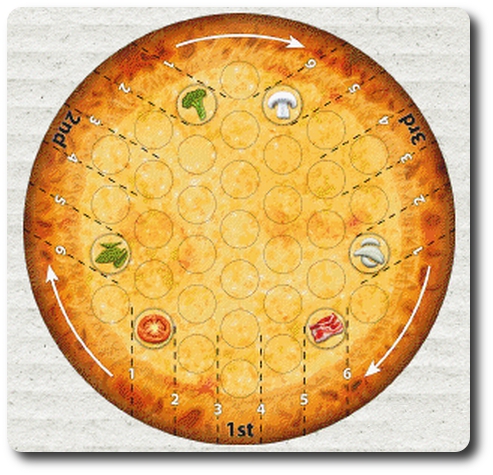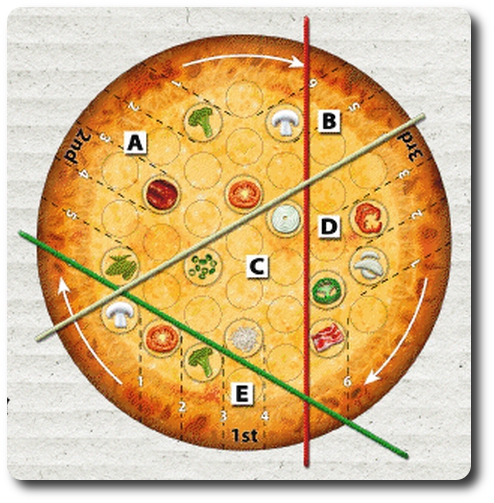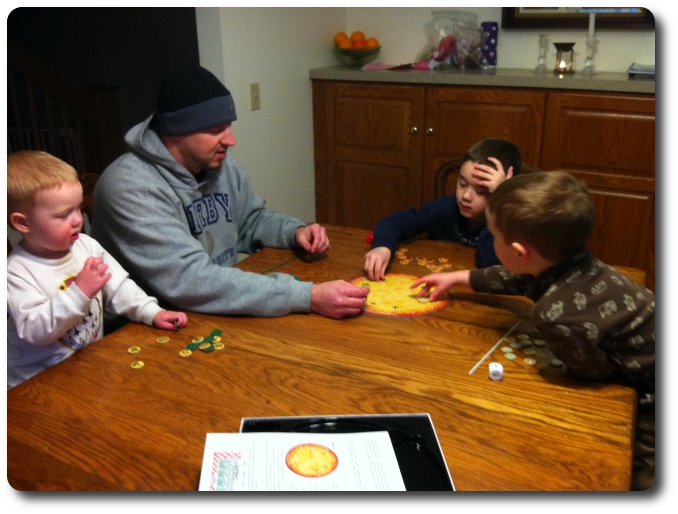 The Basics:
The Basics:
- For ages 6 and up
- For 2 or 3 players
- About 15 minutes to complete
Geek Skills:
- Counting & Math
- Logical & Critical Decision Making
- Pattern/Color Matching
- Strategy & Tactics
- Worker Placement & Area Control
Learning Curve:
- Child – Easy
- Adult – Easy
Theme & Narrative:
- Let’s make a pizza!
Endorsements:
- Gamer Geek approved!
- Parent Geek approved!
- Child Geek approved!
Overview
Hey! Who’s hungry? Want to order a pizza? AWESOME! Let’s get a Meat Lovers! What do you mean you don’t like pepperoni? That’s weird. OK, how about a Sausage Supreme? No? OK, what do you want? VEGETARIAN!?!?! No way am I paying for a salad pizza! Fine, you know what? Let’s settle this like geeks, and use the pizza theorem. And, no, we are not ordering a side of breadsticks…
Pizza Theory is comprised of 1 Pizza board (I kid you not, it’s a pizza), 3 Pizza Cutters (thin sticks in the colors of red, green, and white – one for each player), 3 wooden six-sided dice (in the colors of red, green, and white – one for each player), and 48 Pizza Topping disks (16 per player in the colors of red, green, and white). The Pizza board and the Toppings are made of thick cardboard and very durable. The six-sided dice are about 3x as large as traditional six-sided die and solid. The only game component that has any semblance of fragility are the Pizza Cutters which are thin and very light weight; however, this is on purposes as the sticks need to be used on the Pizza board without disrupting the toppings.
Don’t worry, it’ll all make sense. Take moment to go get yourself a snack as I’m sure that all this talk of pizza, toppings, and six-sided dice has made you hungry.
How to Bake a Pizza…Board
The Pizza board can be a bit confusing for new players and little geeks at first. There are three positions, 1st, 2nd, and 3rd, and the players will be rotating through these playing positions throughout the game. Located at each position are six dashed lines numbered 1 through 6. The Pizza Cutter sticks will be placed along these lines, crossing from one end of the pizza to the other. Where the sticks cross will create “slices”. Remember this as it is pretty important to the game.
Located on the board are spaces for the toppings, including six spaces that are marked with an “X”. These are the starting positions for two of each player’s toppings. Throughout the game, toppings will be added and removed to these spaces as the players attempt to dominate the pizza with their toppings of choice.

MMmmmmm...that's one tasty looking board....
Lastly, you’ll note that there are three direction arrows located along the pizza crust. These arrows indicate in which direction the positions will shift by one space, going clockwise. For example, if a player was sitting behind the 3rd position, their next position in accordance to the directional arrows would be the 2nd position. The board rotates, not the players. Simply turn the board until each player is behind the next position in the countdown sequence which is 3rd to 2nd, 2nd to 1st, 1st to 3rd, and so on.
Game Set Up
Pizza Theory can be played with 2-players or 3-players. The game set up differs enough from a 2-player to a 3-player game to make it necessary to describe each separately.
For a 2-player game, place the Pizza board in the middle of the playing area and have the players sit opposite of each other, each choosing one of the three positions (1st, 2nd, or 3rd). Next have each player select one of the three colored dice (red, white, or green), the matching colored Pizza Topping disks, and Pizza Cutter stick. The die, toppings, and stick of the color not selected are gathered and set aside; they will be used in the game. Randomly select one of the two players to be the “first player” (board position doesn’t matter) and have them place the unselected die in front of them. Now each player places two of their toppings (doesn’t matter which) in the two “X” spaces on the board located directly in front of their current position. The first player will also place two of the third non-player toppings in the unoccupied position on the spaces marked with an “X”. You are now ready to play the game.
For a 3-player game, place the Pizza board in the middle of the playing area and have the players sit opposite of each other, each choosing one of the three positions (1st, 2nd, or 3rd). Next have each player select one of the three colored dice (red, white, or green), the matching colored Pizza Topping disks, and Pizza Cutter stick. Now each player places two of their toppings (doesn’t matter which) in the two “X” spaces on the board located directly in front of their current position. The player sitting behind the 1st position will be the first player. You are now ready to play the game.
Playing With Your Food
Like the game set up, the difference between a 2-player and a 3-player game are subtle but differ enough to require explanation.
For a 2-player game and at the beginning of each round, the first player (the player currently holding the unselected die) places one of their toppings on the Pizza board in any space that is not next to any of their currently placed toppings. Then the second player does the same. If at anytime a player cannot place a topping, they simply skip this step for the round. Once completed, the first player rolls the unselected die and places the Pizza Cutter stick for that die color on the board using the currently unoccupied position by the players, making certain the stick is on the same line as the number rolled. One unselected topping matching the color of the Pizza Cutter stick is then placed in any unoccupied space that touches the stick. Once completed, each player now secretly selects one of the six sides on their die and then simultaneously reveals their selected value when all the players are ready. Each player now places their Pizza Cutter stick on the line located at the player’s current position that matches the number on their selected die value. The Pizza board should now have three sticks cutting the board into slices (see image below and explanation). In each slice, determine which topping color has the majority. Each topping that is not in the majority is replaced by 1 topping that is. All removed toppings are returned to their owner. If there is a two-way tie, the third color’s toppings are removed from that slice but are not replaced. In a three-way tie, no toppings are removed. Finally, remove all the Pizza Cutters, give the unselected die to a new player, and rotate the Pizza board clockwise until each player is now behind the next position in the sequence to begin the next round.

Using the above image as reference (suitable for a 2-player or 3-player game), when determining topping dominance, the following actions were taken for each slice.
- Slice A: The white topping is removed (two-way tie between red and green toppings)
- Slice B: No toppings, no action
- Slice C: White toppings have dominance, the single green topping is removed and replaced by a white topping
- Slide D: Red toppings have dominance, the single green and white toppings are removed and replaced with one red topping each
- Slice E: Three-way tie, so nothing is removed
Note that there is a “Safety Rule” that states if a color has no more than one topping in any slice, all of that color’s toppings are safe and may not be removed or replaced this round!
For a 3-player game and at the beginning of each round, the player sitting behind the 1st position places one of their toppings on the Pizza board in any space that is not next to any of their currently placed toppings. Then the player in the 2nd position does the same, followed by the player in the 3rd position. If at anytime a player cannot place a topping, they simply skip this step for the round. Once completed, each player now secretly selects one of the six sides on their die and then simultaneously reveals their selected value when all the players are ready. Each player now places their Pizza Cutter stick on the line located at the player’s current position that matches the number on their selected die value. The Pizza board should now have three sticks cutting the board into slices (see image above and explanation). In each slice, determine which topping color has the majority. Each topping that is not in the majority is replaced by 1 topping that is. All removed toppings are returned to their owner. If there is a two-way tie, the third color’s toppings are removed from that slice but are not replaced. In a three-way tie, no toppings are removed. Finally, remove all the Pizza Cutters and rotate the Pizza board clockwise until each player is now behind the next position in the sequence to begin the next round.
Topping Overload
If a player has all 16 of their toppings on the Pizza board at the end of the round, they win the game! In a 2-player game, if the unselected color ever has all 16 of its toppings on the Pizza board, both players lose!
If there is a tie, whichever player would technically have more toppings on the pizza (if toppings were unlimited) at the end of the round is the winner. This deserves a bit of an explanation as the rules are note very clear. When you determine topping dominance, you replace each topping using the 1:1 replacement ratio. If you run out of toppings, you won’t be able to replace all the toppings in a particular slice. You count these toppings, the ones that you would replace if you had more toppings, to determine the tie breaker.
For more information on Pizza Theory, visit the game’s official web site.
Prediction
Abstract strategy games tend to be big winners with my little geeks. According to my 7-year-old, he likes how the game lets him imagine what is going on. I’m lucky in that regard as my little geeks naturally gravitate towards games that champion the use of imagination and critical thinking. This has allowed me to steadily introduce more challenging games and place Candy Land on the top shelf much sooner than your average geek parent. Oddly enough, Hungry Hungry Hippos is still going strong.
When I introduced Pizza Theory to my two oldest little geeks, they only asked me two questions. How do we play and can we have pizza? Pizza isn’t in the cards for a meal anytime soon, but I was most pleased to hear they were eager to learn how to play. With very few bits, simple game play, and a short game length, I had no doubt the game would be an enjoyable experience for my little geeks. Enjoyable, but not necessarily long-lasting. My little geeks are almost always willing to try a game once. This makes it very important that I always introduced a game at just the right moment. If my kids are tired, hungry, grumpy, gassy, or just feeling negative in general, I don’t care if you slap down a game titled HOLY COW! THIS IS THE GREATEST THINGS SINCE CHRISTMAS!, they simply won’t go for it.
So I waited.
When the time was right, I took out the game and invited my little geeks to the family table. I gave each player their topping color of choice, dice, and stick and made certain to include my 2-year-old by offering him an opportunity to help me place my toppings. As always, I like to give my little geeks time to just look at the game, kick the tires so to speak, and ask any questions they might have before I get to the rules. They loved the fact the game board was a pizza. They had never seen a game like Pizza Theory and were eager to see how it worked. When both of my little geeks asked how the game was played, I explained the rules. Again, a rather straight forward game but I took the time to show them why topping placement is important and to follow the lines, imagining stick placement, in their head. My 7-year-old understood this fairly well, but I was not convinced by 4-year-old was “getting it”.
I demoed a quick round so each little geek (including my 2-year-old) could have a trial run before we played. I have always enjoyed trial runs and highly recommend you try the same if you are finding your little geeks stressed when they play. More times than not, and I’m speaking from personal experience here, they are stressed because they are overwhelmed and still trying to grasp all that is required of them. By introducing the game with zero commitment, this allows for a stress free learning curve and gives the parent geek time to adjust according to the mood of the little geeks.
Having completed a demo round, answering any remaining questions (of which there were none), we reset the board for our first game. While I did so, I asked my little geeks their thoughts on the game so far.
“This looks like a neat game. Never played a food game before.” ~ Liam (age 7)
“I like how I get to make the pizza my way, Daddy!” ~ Nyhus (age 4)
“Peetha!” ~ Ronan (age 2)
Looks like the little geeks are “hungry” to get started. Yes, I know, horrible pun.
Final Word
Pizza Theory was a great success with my little geeks! My 7-year-old did very well, planning his topping placement intelligently, made meaningful line number choice to maximize his topping superiority, and most importantly, didn’t freak out when he lost control of a specific slice. In fact, he laughed when he did. This greatly pleased me as he was demonstrating the proper emotional coping skills we adults take for granted.
My 4-year-old’s experience is not a success story. While he understood the game rules and what was expected of him, he struggled to make meaningful choices when it came to topping placement and line number selection for his stick. It was clear he was randomly making choices without considering the “next step”. This is perfectly fine for the first game as you learn how things work, but not after you’ve played the game 5 times or more. His random choices and lack of strategy and skill is not a surprise or disappointing. He’s 4-years-old and is learning. He has come a very long way in a very short amount of time and continues to get better and better. Based on his game play and experience, I cannot recommend this game for little geeks who are 4. Your own experience with your little geeks will, of course, vary.
My 2-year-old was a great helper and I am very pleased to report he did not put a single piece of the game in his mouth! PROGRESS!
With little geeks, the game plays very well and fast. It is light and fun where emphasis is placed on “what do I need to do now” instead of being a tremendous brain burner to think 2 or 3 moves ahead. This makes it a fun game for both the little geeks and the parent teaching them. No stress gaming at its finest. The same cannot be said for the adults.
An interesting thing happens when you shift gears from playing games with your kids to playing the same game with adults. The table is still friendly, but there is a heightened sense of competitiveness that immediately makes everyone at the table a little bit more on edge. This always amuses me as a game experience can be completely different depending on who you are playing it with even if it is the exact same game. When I played Pizza Theory with adults, especially the Gamer Geek crowd, the game went from breezy and fun to wickedly cutthroat and serious. This brought out an entirely different side of the game I had not yet experienced and I got say, I liked it. I liked it a lot. Much more so when I played it with my little geeks. Now every topping placement counted, every slice was a possible victory or massive defeat. Several times I would see whole sections of the pizza shift from one player to another, drastically challenging the balance of the game. This not any different when playing the game with my little geeks, but if felt much more visceral.
I feel the need to address two items that seem to be discussed often when this game is being reviewed. First, there is no randomness in this game. Players make every choice without using any type of randomized process to determine what they can or cannot do. The outcome the player’s choices, which are selected in secret, are what I believe some individuals are calling “random”. Each player can only select 1 of the possible 3 cuts that will define the slices. This doesn’t give any specific player much in the way of real control over where the final lines will be drawn. Using the board and topping placement as a guide, you can always see where you want to divide and conquer, but until the other players place their sticks, the board is wide open. For some, this might feel “random” and turn them off.
The other aspect of the game that I think is being misrepresented is the lack of meaningful choice. At the beginning of the game, players have no set direction in which they place their toppings. It is only when the slices are created and we begin to see more and more portions of the pizza being taken over that we begin to get some direction. Ironically, we also start to have the number of options available to us reduced. The pizza board communicates a tremendous amount of information to the player if they know where to look. It is easy to count the number of toppings each player has and needs to yet place to win the game, you can see all the possible cuts a player will attempt based on their position that would benefit them, and you can even see what is possibly coming up on the next round. Emphasis here on the “possible” because the topping dominance can shift greatly and is never known until the end of the round. This made my head hurt when I was attempting to out think my opponents. There were many choices to be made and lots to think about each turn. My options were reduced as the game play continued, but never did I feel like I had nothing to think about.

My two oldest little geeks and I play a game of Pizza Theory while my youngest helps me with my toppings
Gamer Geeks, this is a fun and deceptively breezy abstract strategy game where your worker placement and area control skills will be put to the test. Your position, and therefore point-of-view, on the game will constantly shift as will the pizza topping landscape. You’ll need to think hard about the choices you’ll make, try your best to think like your opponent, and then cross your fingers that you are doing everything right. In a single turn, you can see the game quickly turn in your favor or kick you in squarely in the teeth. The game moves fast keeping you on your toes and you’ll feel the pressure and the pinch as the board becomes and more difficult to navigate and control.
Parent Geeks, this is a wonderful game to play with family and friends, but sadly only sits 3. A real disappointing here as the game is a wonderful experience. The 2-player and 3-player game play differently enough to make each a unique experience and a fun one at that. This game will help you introduce probability and simple mathematics to your little geek and the wonderful world of cause and effect. For educators, this game will be a great way to introduce the very basics of geometry and for those hardcore mathematicians, this game is going to keep you busy attempting to formulate possibilities and probabilities. You’ll never look at your takeout pizza the same way again.
Child Geeks, this is going to be a fun game to play with Mom and Dad, Grandma and Grandpa, and your siblings (if you like each other). You get to make your own pizza, but don’t be surprised if you see your toppings of choice get booted off the cheesy pizza top as the another players take control! Don’t get discouraged, however, as every round provides you with a new opportunity and new choices. Keep at it, think about what you are doing, think about what your opponents might do, and you’ll start to see the many different ways you can play your turn and make a real difference on that pizza!
Pizza Theory is a winner in my house and with my friends. Geeks, parents, and the little geeks all agreed that the game was a fun and challenging experience. Gamer geeks put is squarely in the “good” category, approved it and were ready to play another game. Parents enjoyed the way it introduced mathematics and the easy way it played. Child geeks, while they enjoyed the game, were even more in love with the idea they were playing on a pizza. Personally, I’d order up a game of Pizza Theory anytime.
Again, sorry about the bad puns. Can’t be helped.
This game was given to Father Geek as a review copy. Father Geek was not paid, bribed, wined, dined, or threatened in vain hopes of influencing this review. Such is the statuesque and legendary integrity of Father Geek.



